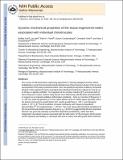Dynamic mechanical properties of the tissue-engineered matrix associated with individual chondrocytes
Author(s)
Unknown author
DownloadGrodzinsky-2010-Dynamic mechanical properties of the tissue.pdf (1.617Mb)
OPEN_ACCESS_POLICY
Open Access Policy
Creative Commons Attribution-Noncommercial-Share Alike
Terms of use
Metadata
Show full item recordAbstract
The success of cell-based tissue engineering approaches in restoring biological function will be facilitated by a comprehensive fundamental knowledge of the temporal evolution of the structure and properties of the newly synthesized matrix. Here, we quantify the dynamic oscillatory mechanical behavior of the engineered matrix associated with individual chondrocytes cultured in vitro for up to 28 days in alginate scaffolds. The magnitude of the complex modulus (|E*|) and phase shift (δ) were measured in culture medium using Atomic Force Microscopy (AFM)-based nanoindentation in response to an imposed oscillatory deformation (amplitude ∼5 nm) as a function of frequency (f=1–316 Hz), probe tip geometry (2.5 μm radius sphere and 50 nm radius square pyramid), and in the absence and presence of growth factors (GF, insulin growth factor-1, IGF-1, and osteogenic protein-1, OP-1). |E*| for all conditions increased nonlinearly with frequency dependence approximately f[superscript 1/2] and ranged between ∼1 and 25 kPa. This result, along with theoretical calculations of the characteristic poroelastic relaxation frequency, f[subscript p], (∼50–90 Hz) suggested that this time-dependent behavior was governed primarily by fluid flow-dependent poroelasticity, rather than flow-independent viscoelastic processes associated with the solid matrix. |E*(f)| increased, (f) decreased, and the hydraulic permeability, k, decreased with time in culture and with growth factor treatment. This trend of a more elastic-like response was thought to be associated with increased macromolecular biosynthesis, density, and a more mature matrix structure/organization.
Date issued
2010-02Department
Massachusetts Institute of Technology. Department of Materials Science and Engineering; Massachusetts Institute of Technology. Center for Biomedical Engineering; Massachusetts Institute of Technology. Department of Electrical Engineering and Computer Science; Massachusetts Institute of Technology. Department of Mechanical Engineering; Massachusetts Institute of Technology. Department of Biological EngineeringJournal
Journal of Biomechanics
Publisher
Elsevier Ltd.
Citation
Lee, BoBae et al. “Dynamic mechanical properties of the tissue-engineered matrix associated with individual chondrocytes.” Journal of Biomechanics 43 (2010): 469-476. Web. 26 Oct. 2011. © 2010 Elsevier Ltd.
Version: Author's final manuscript
ISSN
0021-9290